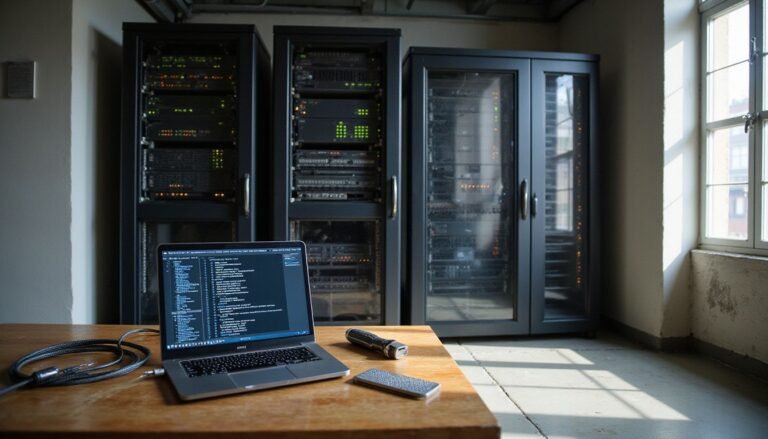
Securing your business online is becoming tougher. Network security controls are key. This post covers crucial tools and strategies for 2025.
Network security helps protect against cyber threats, like malicious software and data breaches. It includes tools such as firewalls, antivirus software, and intrusion prevention systems (IPS).
These tools guard against unauthorized access to networks and sensitive information.
Access control is another important aspect. It ensures only approved users can view or use certain data or applications. Techniques like role-based access control (RBAC) help manage who has what level of access.
For web security, securing apps and emails is critical to prevent attacks from the internet. Application security measures protect apps from threats, while email security prevents scams and phishing attempts.
The cloud introduces new challenges in cyber security but also offers solutions like cloud security services which safeguard data stored online.
Virtual private networks (VPN) encrypt internet traffic, providing secure connections over the internet. This is vital for remote work or when using public Wi-Fi networks.
Security information and event management (SIEM) systems track potential issues in real-time by analyzing network behavior—a must-have for spotting cyber threats early on.
Lastly, cybersecurity isn’t just about technology; policies play a huge role too—from risk assessments that identify vulnerabilities to penetration testing that checks defenses’ strength.
Key Takeaways
- Protect your network with firewalls, VPNs, and IDS/IPS to stop unauthorized access.
- Use data loss prevention tools and encrypt information to secure sensitive data.
- Train staff on security rules and control access based on their roles.
- Keep systems up-to-date and perform security checks to spot weaknesses.
- Implement behavioral analytics and AI for quick threat spotting.

Understanding Security Controls

Security controls act like guards, blocking bad players to protect IT security. They ensure only the right people access files, keeping networks and applications safe.
Technical Security Controls
Technical security measures safeguard corporate computer networks from potential breaches. Firewalls are instrumental, filtering information across different communication levels, from layer 2 to layer 7.
They permit or restrict traffic based on pre-established rules.
Intrusion Detection Systems (IDS) keep an eye on network activities, and issue warnings upon spotting anomalous operations. Intrusion Prevention Systems (IPS) don’t just identify but also halt threats in real-time, functioning as preemptive protectors.
Virtual Private Networks (VPNs) secure data by employing encryption through SSL/TLS and IPsec protocols. This coded communication hinders unauthorized individuals from intercepting vital information during transmission over the internet.
Data Loss Prevention (DLP) systems scrutinize both incoming and outgoing data to avert significant information loss or theft. These instruments are key in preserving network confidentiality, integrity, and availability against a variety of risks.
Administrative Security Controls
Access control keeps only the right people reaching important data. Rules set who can enter your network and monitor their actions. This involves creating access control lists, which specify access rights for users.
Security measures like passwords or smart cards verify users’ identities.
Once verified, authorization defines what resources a user can access or actions they can perform. Accounting tracks all user activity on the network, acting as a detailed record of each action taken.
Logging and monitoring are crucial too. User activities generate logs analyzed by security information and event management (SIEM) systems. These systems help identify any suspicious behavior by reviewing records from various network parts.
Clear administrative controls improve security and efficiency in workplaces by managing who accesses what resources and when, preventing potential issues before they start.
Physical Security Controls
Physical security stops people from entering places they shouldn’t. It uses locks, cameras, and entry systems to prevent unauthorized access. Tools like key cards or biometric scanners help decide who can enter.
These measures protect devices connected to your network, such as computers, routers, and servers. They need safe locations where only approved people can go. This is crucial not just to thwart thieves but also to avoid accidents by employees that could disrupt the network.
Firewalls play a key role in blocking unwanted access to your network. They act as barriers against external threats trying to penetrate your digital space. By monitoring incoming and outgoing traffic, firewalls ensure only safe connections are made with your network.
This defense helps maintain data confidentiality and protects against malicious websites and cyber attacks on web security.
Key Network Security Measures
Network security is like a fortress, using barriers, alerts for intruders, encrypted paths for data, and monitoring to protect business information. These tools act as defenses against unauthorized access and keep valuable data safe.
Firewalls
Firewalls serve as guards for a business’s internet access, screening data to ensure only safe transactions occur. Companies such as Cisco provide advanced firewalls capable of preemptively identifying threats.
These tools are essential for protecting against leaks of sensitive information. They operate on multiple levels of the internet, handling tasks from email security to complex web applications.
Firewalls use proxy services to examine data thoroughly, offering a robust first line of defense in network security by regulating entry based on established rules.
Intrusion Detection and Prevention Systems (IDPS)
Intrusion Detection and Prevention Systems (IDPS) play a vital role in network security. These come in two forms: network-based, which monitors all network traffic for signs of trouble, and host-based, focusing on individual computers or servers.
Both types identify suspicious activity to prevent unauthorized access..
For example, using an IDPS helped detect unexpected threats in my small business that I hadn’t spotted. This highlights their importance for safeguarding data..
These systems function either by observing and recording incidents (IDS) or actively intervening to neutralize threats (IPS). IDS acts as a surveillance system, while IPS is like having a proactive guard.
Recent updates since 2016 have enhanced their ability to defend networks against attacks.
Implementing these systems ensures data protection from breaches. Moving on, Virtual Private Networks (VPNs) are essential for secure internet connectivity by encrypting the web access from your devices.
They hide your IP address for private browsing, adding another layer of security against cyber threats.
Virtual Private Networks (VPNs)
VPNs act as secure tunnels for internet data, using encryption methods like IPsec or SSL. This encryption ensures online activities remain private, vital in a world where over 2,200 cyberattacks occur daily. By encrypting data, VPNs ensure that only intended recipients can decipher the communication. This method is especially critical for small business owners to protect sensitive information against unauthorized access common in wireless networks and cloud services..
Data Loss Prevention (DLP) Systems
Moving from VPNs, small business owners must implement Data Loss Prevention (DLP) systems. These systems protect sensitive information and ensure compliance with GDPR, HIPAA, and PCI DSS regulations. Microsoft Purview and Google Cloud DLP are useful for identifying where critical data resides and managing access permissions. They conduct deep content inspections to maintain data confidentiality.
Forcepoint DLP effectively prevents unauthorized data sharing outside your network by monitoring data use and stopping leaks early. This technology is vital for avoiding fines and safeguarding your company’s reputation in the digital age.
Network Security Best Practices
To shield your enterprise from online attacks, adhere to these best practices for network security:
- Deploy firewalls and employ data encryption to prevent unauthorized entry and protect confidential data.
- Consistently update systems and applications to eliminate any security gaps that hackers might take advantage of.
- Establish multi-factor authentication (MFA) for reinforced protection. This ensures data stays safe even if passwords are stolen.
- Conduct routine security checks to pinpoint and resolve vulnerabilities in your network, lowering the probability of attacks.
- Train staff members on sound password habits and the significance of security consciousness. Well-informed employees are crucial in blocking breaches.
- Formulate a contingency plan for rapid retrieval of vital data after any loss event, guaranteeing ongoing business operations.
- Apply intrusion detection systems (IDS) for early detection of questionable activities, curtailing possible harm before it escalates.
- Incorporate virtual private networks (VPNs) to code remote access connections, maintaining external scrutiny at a distance.
- Apply network access control (NAC) principles to regulate network access based on employee roles and duties, improving the general security stance.
With consistent application of these strategies, companies can establish a solid defense against a range of online threats as we progress into 2025.
Network Security Fundamentals
Network security is critical for protecting businesses from cyber threats. The first step is access control, ensuring only authorized individuals can access sensitive information. Access control acts like a strong lock, guarding against unauthorized entry.
A malware attack taught me the importance of keeping software and systems updated to block emerging threats. Firewalls serve as protective barriers against external dangers. Multi-factor authentication strengthens security by verifying user identities in several ways.
Educating employees on recognizing suspicious emails and links is essential for preventing breaches. Conducting regular audits identifies vulnerabilities before attackers exploit them.
Complying with data protection laws avoids legal issues and fines related to information security.
These measures form a comprehensive defense strategy, safeguarding business data from cyber attacks effectively.
Developing a Robust Network Security Policy
To build a strong network security policy, follow these steps:
- First, identify your sensitive information and its locations.
- Classify your data by its level of importance.
- Implement role-based access control to manage data access.
- Write guidelines that include encrypting important information.
- Conduct regular security audits to ensure your measures are effective.
- Train your employees on security best practices and your company’s policies.
- Create a plan for responding to data breaches and security incidents.
- Update your policy to adapt to new threats and significant business changes.
Keeping these steps in focus ensures a secure environment without overcomplicating the workflow.
Advanced Security Tools for 2025
By 2025, companies will have access to advanced technologies. These will protect networks using smart technology and data analysis.
Behavioral Analytics
Behavioral analytics, through tools like Cisco Secure Network Analytics, scans large data sets for unusual patterns. It enhances network security by identifying suspicious activities that could indicate threats.
This method adapts to block new kinds of attacks quickly.
For small business owners, this technology is crucial in preventing data breaches and blocking unauthorized access. It makes networks smarter and faster at detecting dangers, helping to keep a company’s data secure.
Security Information and Event Management (SIEM)
Security Information and Event Management (SIEM) collects security data to detect and tackle threats. It acts like a network’s guard, allowing businesses to monitor activities in real time and halt issues promptly.
For instance, SentinelOne pairs artificial intelligence (AI) with its Singularity Data Lake for fast data analysis.
Moreover, SIEM helps companies comply with regulations such as GDPR and HIPAA by protecting customer data and avoiding penalties. Using SIEM tools has significantly improved threat detection early on.
They provide around-the-clock expert support to prevent attacks or data leaks before they cause damage.
Artificial Intelligence in Threat Detection
Artificial Intelligence (AI) revolutionizes cyber threat detection. It scrutinizes vast data pools to pinpoint irregular activities, warding off threats prior to causing harm to businesses. AI serves as a constantly alert protector, refining its capabilities over time by gaining insights from past attacks.
The same technology also boosts joint efforts by dispersing knowledge about threats amongst various systems. This proves particularly beneficial for small businesses, letting them safeguard their networks without the extravagant costs of extensive security teams. Moreover, behavioral analytics assumes a vital part in network protection, studying user actions to spot possible security breaches at the earliest.
Conclusion
To protect your business online by 2025, start with basics such as firewalls and VPNs. Then add advanced tools like behavior analysis and AI to detect threats. Create a comprehensive plan that includes technical, administrative, and physical strategies.
Keep learning about new technologies to safeguard your data. Making smart security decisions today is crucial for your business’s future.
FAQs
1. What are the essential network security controls to protect my business in 2025?
Essential network security controls include access control, application security, email security, and intrusion prevention systems (IPS). These tools help maintain data confidentiality by preventing unauthorized access.
2. How can I use Network Access Control (NAC) for my business’s network security?
Network Access Control (NAC) allows you to implement role-based access control on your network. It restricts who can access sensitive information based on their role in your organization – a crucial step towards protecting against data breaches.
3. What is Security Information and Event Management (SIEM), and how does it enhance our security posture?
Security Information and Event Management (SIEM) combines behavioral analytics with deep packet inspection at layer 4 of the OSI model – the transport layer. This enables real-time analysis of events across your networks for quicker detection of potential threats.
4. Can wireless networks be secure, or do they pose an inherent risk?
Wireless networks can indeed be secure if you employ proper measures like using a Virtual Private Network (VPN), implementing Wireless Security protocols, and conducting regular vulnerability assessments for any possible intrusions.
5. How important is cloud security when considering overall network protection?
Cloud Security is critical as more businesses rely heavily on SaaS applications and store sensitive data in the cloud. Measures such as Data Loss Prevention(DLP), encryption methods like Secure Sockets Layer(SSL), along with regular risk assessments ensure robust cloud protection.
6.What physical measures should we consider while strengthening our industrial network’s safety?
Physical Security Controls are vital alongside digital safeguards for comprehensive defense-in-depth strategy implementation—this includes securing operational technology(OT) equipment from unauthorized physical tampering or theft.
Discover more from Sheywal.com
Subscribe to get the latest posts sent to your email.



